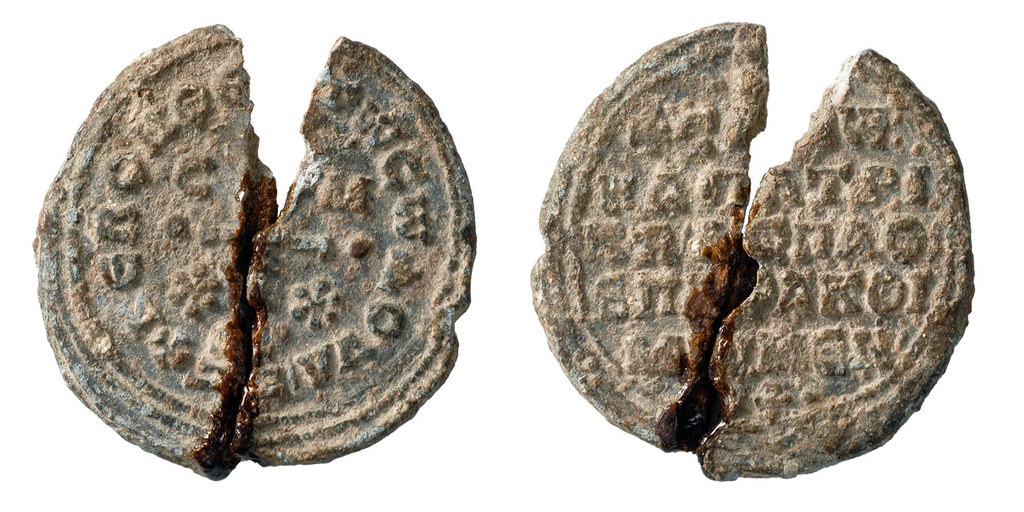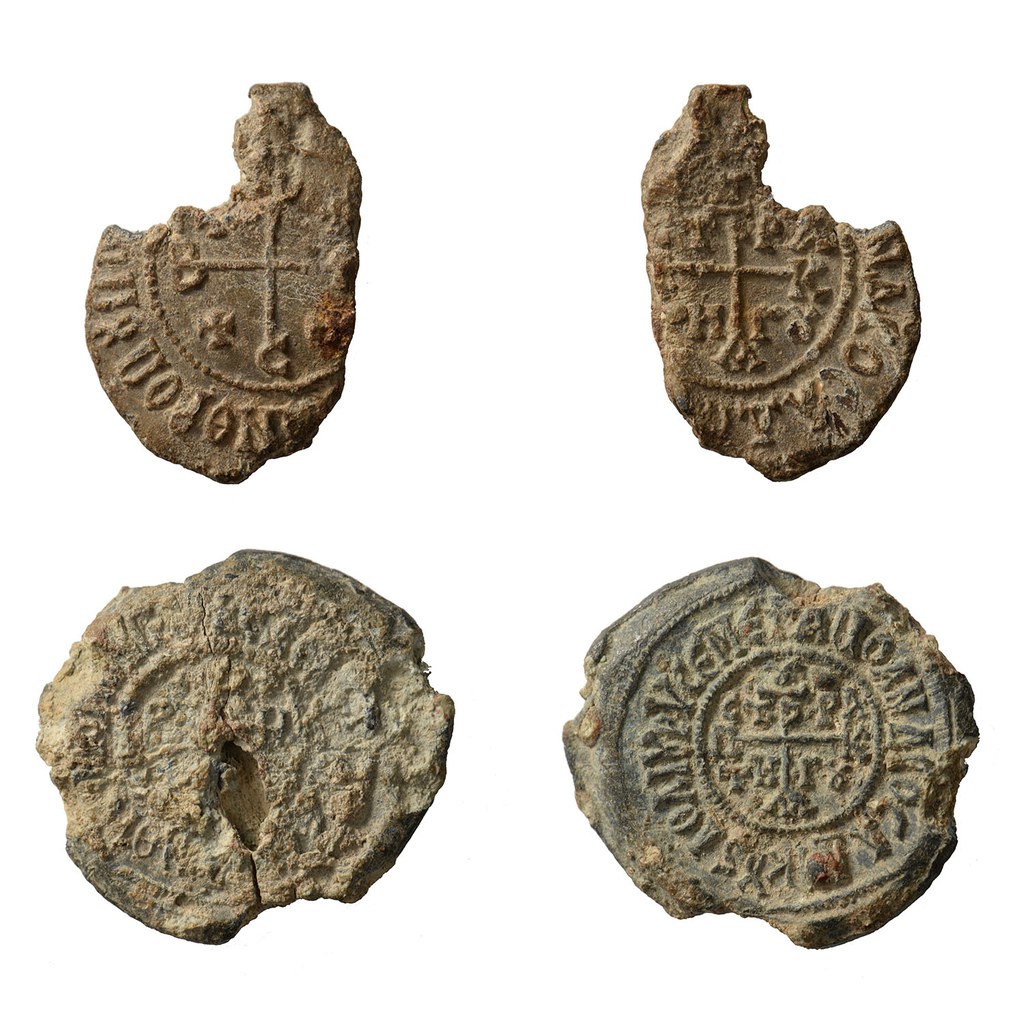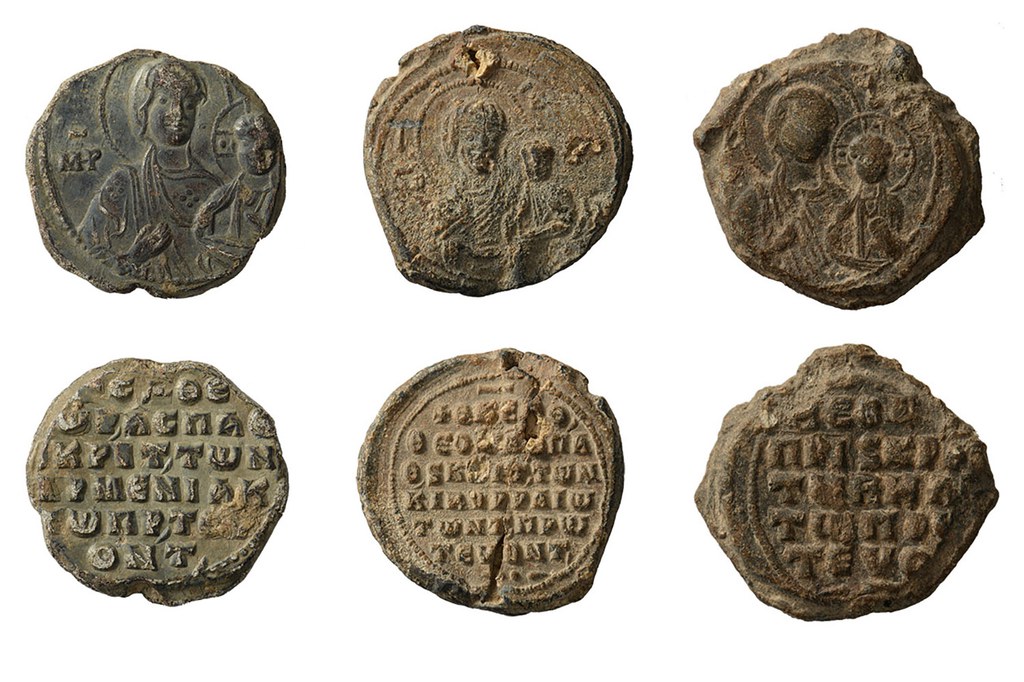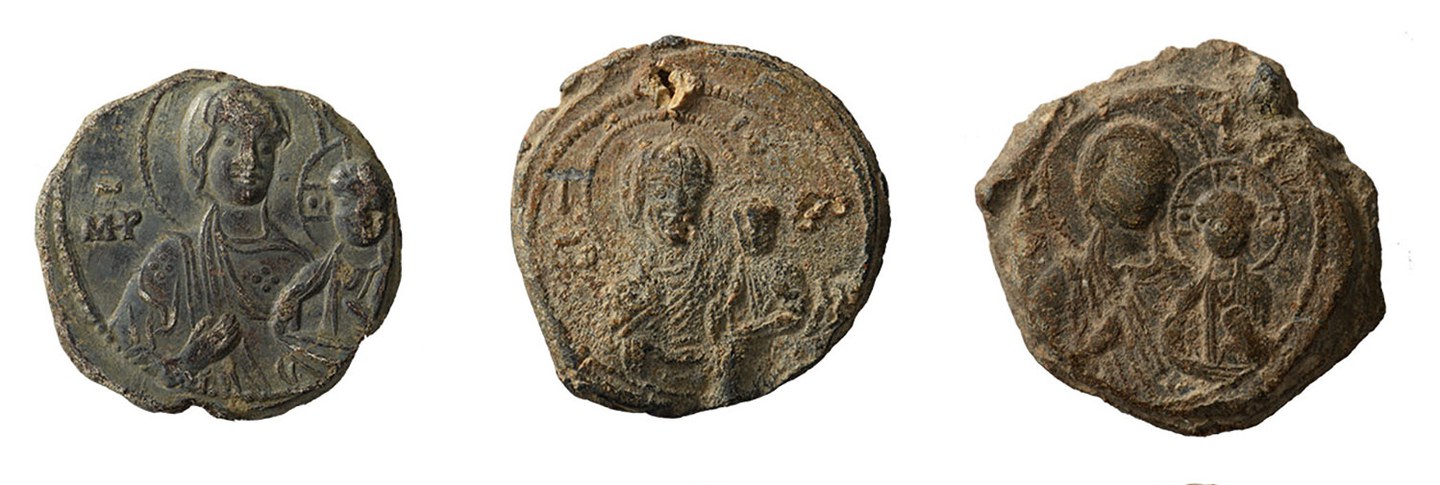By May Wang
Curious about what happens at Dumbarton Oaks when the museum closes and the garden gates lock? Our series “Behind the Scenes” uncovers the hidden activities, surprising jobs, and remarkable discoveries that make a home of the humanities.
Deep in collections storage lie thousands of small imprinted pieces of lead—some 17,000 of them, to be exact—that arguably hold the keys to understanding Byzantine society with more granularity than ever before. These specimens are Byzantine lead seals, which secured and validated documents and correspondence sent in the Byzantine Empire, but were also a small canvas for the senders to represent themselves and their values. Inscriptions might express religious devotion or great family pride, and images or icons can hold clues to the origin of the specimen. “Seals can be a window onto nearly everything to do with Byzantium,” says Jonathan Shea, associate curator of coins and seals, “because they are records of people, and almost everything can be boiled down to people or systems within which people operated.”
Going from a collection of objects to a comprehensive catalogue to be completed by the end of 2021, however, is no small feat, and not merely due to the sheer quantity: each seal is carefully examined, cross-checked, and reviewed before it appears in the Online Catalogue of Byzantine Seals, along with transcriptions, translations, and high-resolution images, in a process that calls for a keen eye, linguistic flexibility, and a far-reaching understanding of Byzantine history and society.
Upon encountering a seal, cataloguers first note the features of the specimen “we might take for granted,” says Shea, like its physical condition. Cracks, like the one on BZS.1947.2.1263, are common among seals, especially along the channel. The channel is a hollow part of a blank seal through which the string tying the document was threaded before the seal was struck. This makes a seal susceptible to corrosion both from the outside and from within, but can also double as confirmation that the specimen is a seal rather than a coin or token, which were fashioned from solid pieces of metal that would be unlikely to corrode in this way.
The inscribed images and text hold the next clues to understanding the specimen, such as which side is the front (obverse) of the seal and which is the back (reverse). “We often start in the middle of the seal and work outward,” explains Shea. In the case of a seal like BZS.1947.2.1263, the middle of one side has an image of a cross mounted on steps and flanked by stars, suggesting this is the obverse. The start of the circular inscription is indicated by a small cross also on this side. Additionally, the letterforms in the epigraphy suggest the seal dates from the early Macedonian period (roughly the latter half of the ninth through the first half of the tenth century), during which time inscriptions accompanying images of crosses often start with an invocation to Christ or Mary; indeed, below the cross on steps the inscription commences with “Lord, help your servant.”
The inscription resumes on the reverse, offering concrete pieces of information that, paired with the overall style of the specimen and external sources, help establish dates for the seal. The invocation is on behalf of Samonas, a well-known eunuch court official in the early tenth century who appears in written sources. “By aligning the inscriptions with what we know from external sources, we can date this seal much more concretely than otherwise,” explains Lain Wilson, digital content manager. The seal identifies Samonas as a patrikios, imperial protospatharios, and a parakoimomenos, so it can be specifically dated between 907 and 911.

Once an individual seal has been described as wholly as possible, cataloguers look for seals that are related either in appearance or even by owner. “Looking for similar or identical inscriptions can be challenging because of the varying conditions of the specimens,” says Wilson, but by comparing the relative position of elements like images and letters in the matrix—the design of the seal—cataloguers can find parallels that complement the information an individual specimen offers. The Samonas seal is mostly legible on its own, but much of the inscription on a fragmentary eighth-century seal attributed to Beser (BZS.1958.106.1835), for example, has worn away with the rest of the seal, and a more complete and very similar example (BZS.1958.106.2308) helps decipher the former’s inscription.

Seals that are not identical but can be attributed to the same person can help trace the movement of an individual through the Byzantine Empire. Three seals in the Dumbarton Oaks collection employ the icon of Theotokos (the Virgin Mary) holding the infant Christ on the obverse and invoke divine protection for the same sealholder, Theodore Proteuon. But Theodore’s titles and offices are different on each seal, tracing his ascent from protospatharios and judge (governor) of the Armeniakoi (1951.31.5.495) and the Kibyrraiotai (1951.31.5.699) to patrikios and judge of the Velum (BZS.1958.106.2515).

Finally, each specimen and those closely related to it are connected to the broader known history of the Byzantine Empire, which can provide excitingly granular insights into particular moments of Byzantine history. “Some seals are unique attestations of families or individuals,” says Wilson, “so they’re important in establishing a historical geography and prosopography context.” Michael Psellos’s Chronographia, a history of the Byzantine Empire from 976 to 1078, for example, recounts the opening of the Senate to members of Constantinopolitan guilds. A seal attributed to Nicholas Katechanas (BZS.1947.2.1048) confirms the prominence of guilds at the time, naming Katechanas as a protospatharios and a “primikerios ton synegoron,” or primikerios of the lawyers, a guild known to exist in the eleventh century. Both familiar and unique attestations are cross-checked with other seals catalogues or prosopographies, such as the Prosopographie der mittelbyzantinischen Zeit, covering the period 641 to 1025, or the Prosopography of the Byzantine World, covering the period 1025 to 1180.

Eventually, all the discoveries are compiled into a catalogue entry for review by other members of the seals cataloguing team before publication. Catalogue entries include transcriptions using both the Athena Ruby typeface and polytonic Greek as well as an English translation, and sections devoted to parallel or related seals and commentary on the broader context encourage users to further explore seals and the catalogue.
The cataloguing process presents opportunities to think creatively about making the seals accessible and useful to a wide audience. The need to transcribe the epigraphy led to the development of the Athena Ruby font, which can be used in a browser-based format or downloaded, and includes ligatures, abbreviations, and variant letterforms that allow for accurate transcription. Gio DiRusso, the cataloguing and exhibition of Byzantine seals summer intern, notes the practice of preserving variant or apparently erroneous spellings is useful for accurately representing the phonology of Byzantine Greek, which is another new angle into Byzantine culture that seals can provide. Additionally, the register of the translations is crafted with a broad range of readers in mind, using what DiRusso describes as more idiomatic translations rather than “stilted, though technically more grammatically correct” ones.
The process of cataloguing one seal—let alone 17,000 of them—might sound daunting, but it’s a challenge the team thinks is well worth the payoff. “There’s almost no topic in Byzantine studies that can’t potentially be enhanced by seals,” says Wilson, “and the core competency really necessary to get started with them is linguistic, so anyone familiar with the languages on seals (most importantly Greek, but also Latin, Arabic, Syriac, and Armenian) is equipped to enhance their study with seals.” The vivid insights and comprehensive understanding of Byzantine society that can be garnered from the collection is also “why cataloguing is important,” adds Shea. “You have to know what you’ve got, otherwise you can’t use them to explore Byzantium.”
May Wang is postgraduate writing and reporting fellow at Dumbarton Oaks.

